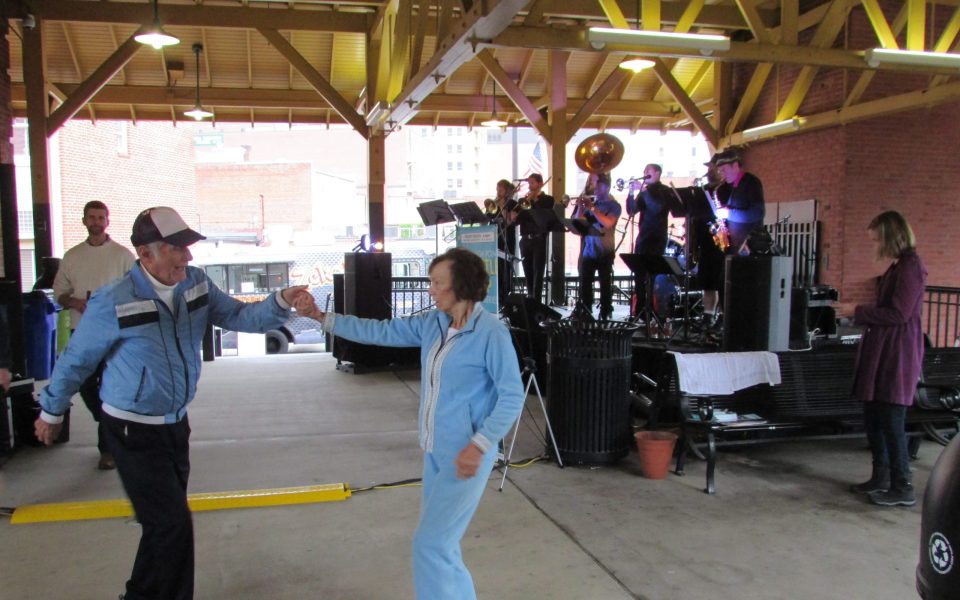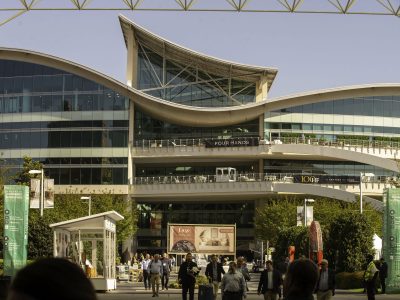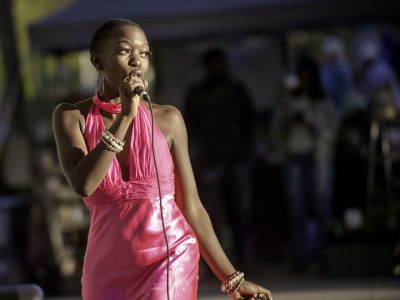The best ticket on a Friday evening in downtown High Point is undoubtedly the free, weekly party hosted by City Project at the Amtrak station known as the Ignite High Point Whistle Stop Concert Series.
Boom Unit Brass Band, which kicked off the season on May 20, had the task of energizing a small but enthusiastic crowd — those who were willing to brave the light mist and occasional spitting rain. On the upside, there was free curbside parking on Main Street, with capacity to spare, less than half a block from the venue. Those who turned out quickly discovered the upper deck of the station was amply sheltered, the Zeko’s Pizzeria & Grill food truck parked nearby on the street, wine and beer available for purchase, and the band hot.
Like an Episcopal church service, a good brass band provides a sensory feast of pageantry, with the possible exception of incense. As an instrumental unit designed to project without electronic amplification — and thus a precursor to R&B and rock and roll — brass bands hold the advantage of mobility over their plugged-in counterparts, or even an emcee tethered to turntables or production unit. And face it, those Sousaphones towering overhead like oversized puppets make an impression that even the most charismatic guitar slinger would be hard pressed to match.
Boom Unit Brass Band made a respectable entrance during their High Point debut, with the musicians processing across the walk bridge that traverses the recessed train track as they performed the band’s signature intro, written by Sousaphone player Jeremy Boomhower (his real name!) and saxophonist Brannon Bollinger — who arrange all the band’s material — as drummer Gary Mitchell laid down an unstoppable beat as the only fixed-location player.
Boom Unit, which is raising money through a GoFundMe campaign to pay for its first album, might not turn many heads in a second line through a New Orleans housing project, but in North Carolina their music is nothing short of irresistible.
Urging the audience to check out the band’s YouTube page, Bollinger said, “It should be pretty easy to find because there aren’t a lot of brass bands around.”
Empire Strikes Brass, from Asheville (who played last year’s Ignite High Point Whistle Stop Concert Series) might be Boom Unit’s only competition across the state. Empire is a couple paces ahead, with augmentation from a guitarist and keyboardist that allows their sound to morph into conventional funk, a DJ unit, and a resume that includes sit-in work with Warren Haynes and Yo Mama’s Big Fat Booty Band, among others.
But Boom Unit might be the only proper brass band in the Triangle. There’s certainly room for both bands to hold down at separate ends of the state and evangelize the hinterlands between. Boom Unit’s playing still shows the rough edges of a young band working out the kinks, but its stylistically diverse repertoire demonstrates the reach expected of a contemporary brass band. The format may be old school, but the social role of a brass band requires the musicians to be able to entertainment audiences of all age groups.
The band ably performed standards like “Cissy Strut” and “Bourbon Street Parade.” The latter song, the second in the set, inspired an elderly couple to demonstrate some elaborate swing dancing moves, including a creaky straddle, a worm-like wiggle on the floor and one in which the lady came to rest sitting on the gentleman’s bended knee at the end of the number. The couple dominated the dance area, with the exception of the occasional soul train line, enhancing the delight of the younger members of the audience for the duration of the concert.
The band’s more contemporary repertoire included covers of the Eurythmics’ “Sweet Dreams,” entertaining passengers waiting on the platform below for the Charlotte-bound Carolinian train; a muscular reading of Pharrell Williams’ “Happy”; a workout of Mark Ronson’s “Uptown Funk” that dialed back the Morris Day & the Time reference of the original to a sound more akin to War in the early ’70s. Boom Unit’s cover of the early ’90s alt-rock classic “Say It Ain’t So” by Weezer was a clear crowd favorite.
“Down to the River to Pray,” popularized by Alison Krauss in the Coen brothers 2000 film O Brother Where Art Thou, proved to be a counterintuitive traditional, pairing nicely with “Li’l Liza Jane,” a song with boisterous call-and-response vocals that has found a home in both the bluegrass and traditional jazz worlds, while becoming a standard of New Orleans brass band music.
The band further hacked notions of nostalgia and cultural relevancy with an early ’90s-era hip hop medley that ranged from Digital Underground to Digable Planets, with various members spitting rhymes and the musicians running through a catalogue of hooks.
“Some of the young people are like, ‘What is this?’” Bollinger quipped. “Google it. Some of the old people are wondering, too.”
Tucked into their stylistically vast and chronologically long song bag, Boom Unit played two originals that are strong enough to hold their own with staples of the genre, including Bollinger’s baroque-sounding “Workin’ Blues” and Boomhower’s appropriately named “Second Line Ska,” with an overt nod to the James Brown/James Bond-inspired instrumental “Sock It to ’Em JB.” Most people are familiar with the Specials’ version, but the smart money says Rex Garvin & the Mighty Cravers originated the tune.
During the final number — a cover of Rebirth Brass Band’s “You Move Ya Lose” — the musicians filed off stage one by one, forming a circle in the middle of the audience, and at the band’s request the sound system went off so they could finish out acoustically.
From whence it came, the music returns.

Join the First Amendment Society, a membership that goes directly to funding TCB‘s newsroom.
We believe that reporting can save the world.
The TCB First Amendment Society recognizes the vital role of a free, unfettered press with a bundling of local experiences designed to build community, and unique engagements with our newsroom that will help you understand, and shape, local journalism’s critical role in uplifting the people in our cities.
All revenue goes directly into the newsroom as reporters’ salaries and freelance commissions.





Leave a Reply